service MAZDA 232 1990 Workshop Manual Suplement
[x] Cancel search | Manufacturer: MAZDA, Model Year: 1990, Model line: 232, Model: MAZDA 232 1990Pages: 677, PDF Size: 61.19 MB
Page 2 of 677
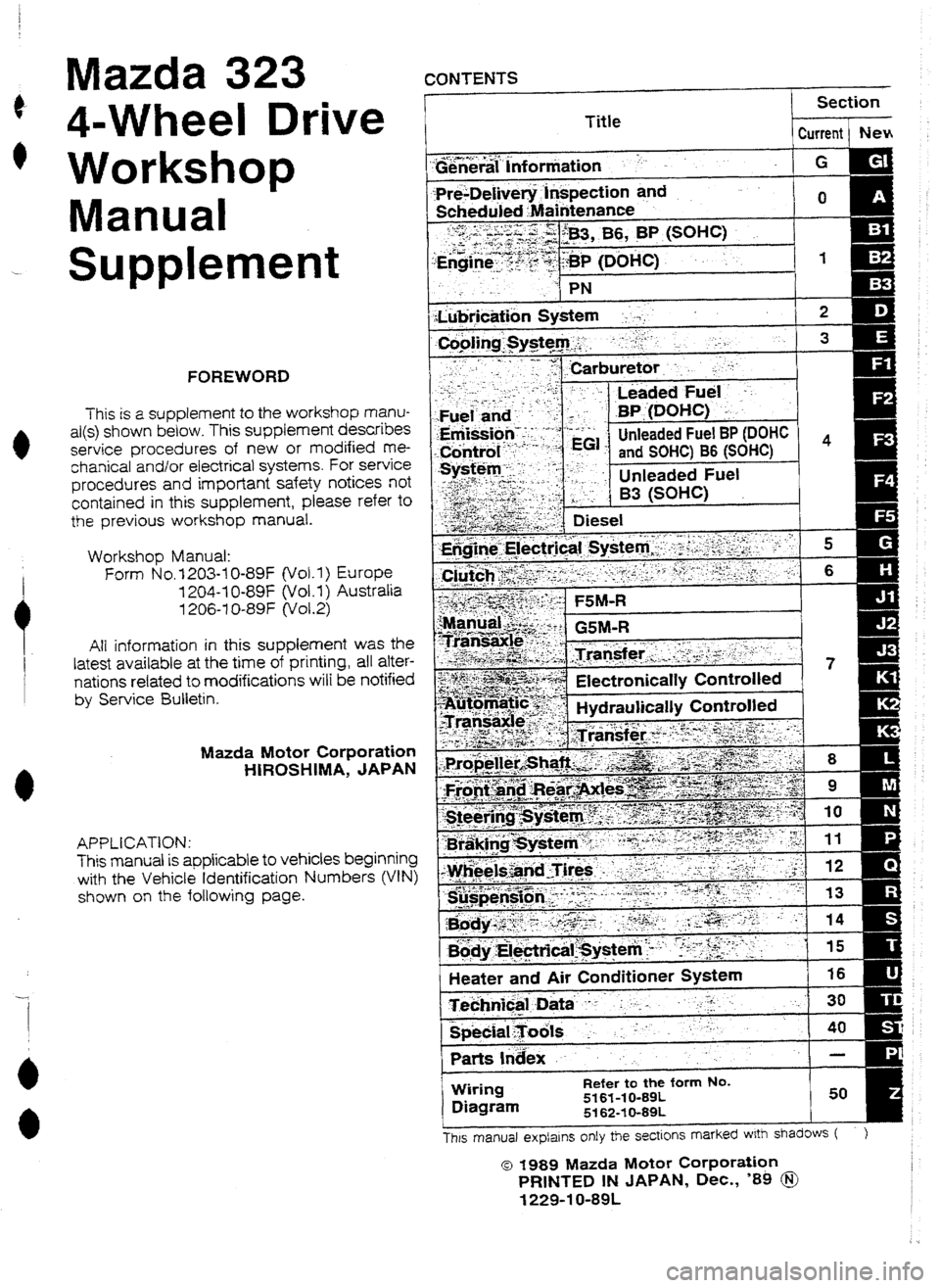
Mazda 323
4-Wheel Drive
Workshop
Manual CONTENTS
Title Section
Current ) NeH
Supplement
FOREWORD
This is a supplement to the workshop manu-
al(s) shown below. This supplement describes
service procedures of new or modified me-
chanical and/or electrical systems. For service
procedures and important safety notices not
contained in this supplement, please refer to
the previous workshop manual.
Workshop Manual:
Form No. 1203-I O-89F (Vol. I> Europe
1204-I O-89F (vol. I > Australia
I ZM-1 o-89F (vol.2)
Ali information in this supplement was the
latest available at the time of printing, all alter-
nations related to modifications wili be notified
by Service Bulletin.
Mazda Motor Corporation
HIROSHlMA, JAPAN
APPLlCATlON:
This manual is applicable to vehicles beginning
with the Vehicle Identification Numbers (UN)
shown on the following page. Electronically Controlled
Wiring
Diagram
Refer to the form No. 5161-l O-89L
5162-t O-89L
Thrs manual explarns only the sectIons marked with shadows ( ) 0 1989 Mazda Motor
Corporation
PRlNTED IN JAPAN, Dec., ‘88 @$ 1229-l O-891
Page 5 of 677
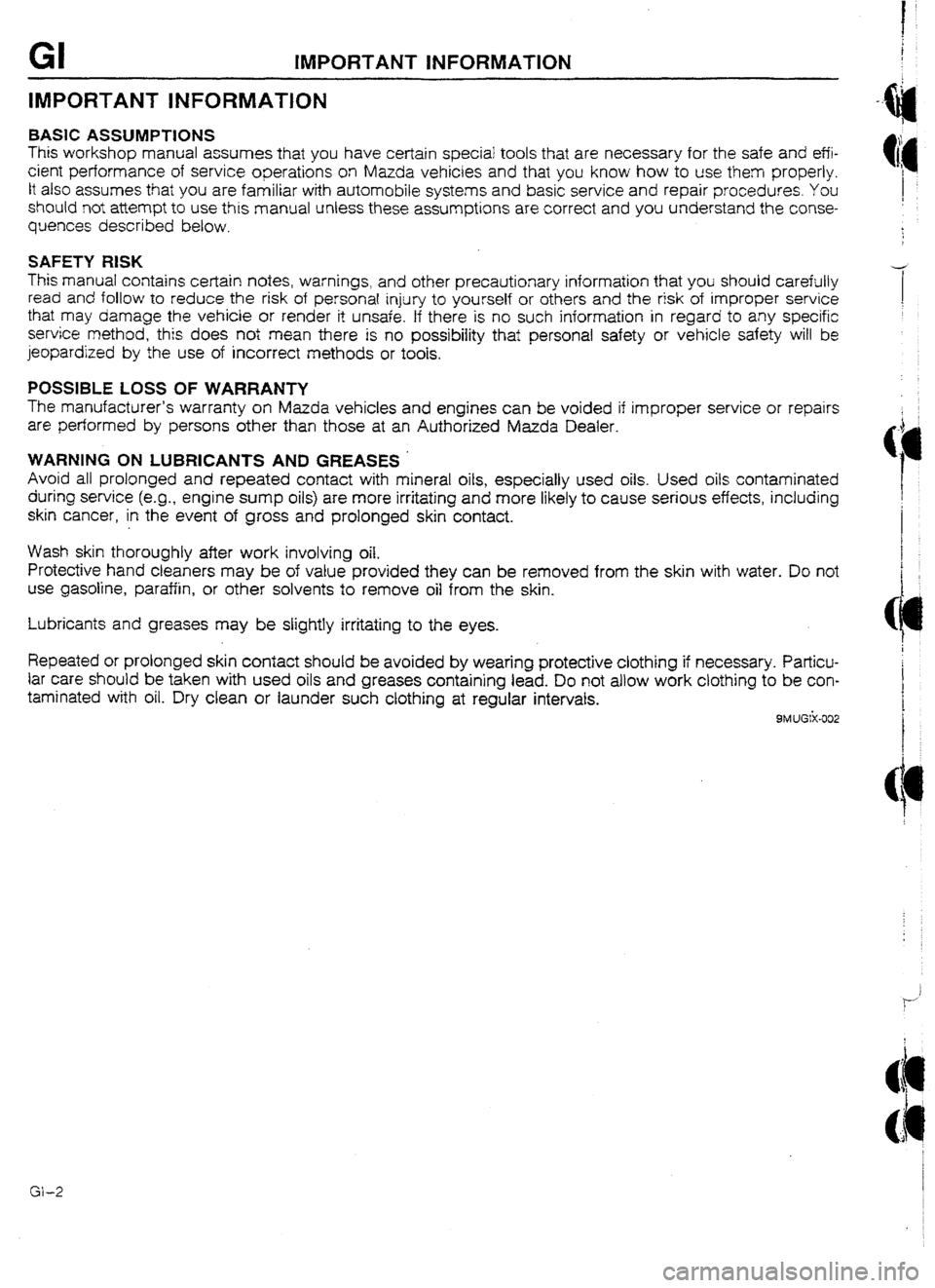
GI IMPORTANT tNFORMATlUN
IMPORTANT INFORMATION
1
.ftl
1
BASIC ASSUMPTIONS
This workshop manual assumes that you have certain special tools that are necessary for the safe and effi-
cient performance of service operations on Mazda vehicles and that you know how to use
them properly.
It also assumes that you are familiar with automobile
systems and basic service and repair procedures. You
should
not attempt to use this manual unless these assumptions are correct and you understand the conse-
quences described below.
SAFETY RlSK
This manual contains certain notes, warnings, and other precautionary information that you should carefully
read and follow to reduce the risk of personal injury to yourself or others and the risk of improper service
that may damage the vehicle
or render it unsafe. If there is no such information in regard to any specific
service method, this does not mean there is no possibility that personal safety or vehicle safety will be
jeopardized by the use of incorrect methods or toots.
POSSIBLE LOSS OF WARRANTY
The manufacturer’s warranty on Mazda vehicles and engines can be voided if improper service or repairs
are performed by persons other than those at an Authorized Mazda Dealer.
WARNING ON LUBRICANTS AND GREASES ’
Avoid all prolonged and repeated contact with mineral oils, especially used oils. Used 08s contaminated
during service (e.g., engine sump oils) are more irritating and more likely to cause serious effects, including
skin cancer, in the event of gross and prolonged skin contact.
Wash skin thoroughly after work involving oil.
Protective hand cleaners may be of value provided they can be removed from the skin with water. Do not
use gasoline, paraffin, or other solvents to remove oil from the skin.
Lubricants and greases may be slightly irritating to the eyes.
Repeated or prolonged skin contact should be avoided by wearing protective clothing if necessary. Particu-
lar care should be taken with used oils and greases containing lead. Do not allow work clothing to be con-
taminated with oil. Dry clean or launder such clothing at regular intervafs.
9MUGiX-502
Page 6 of 677
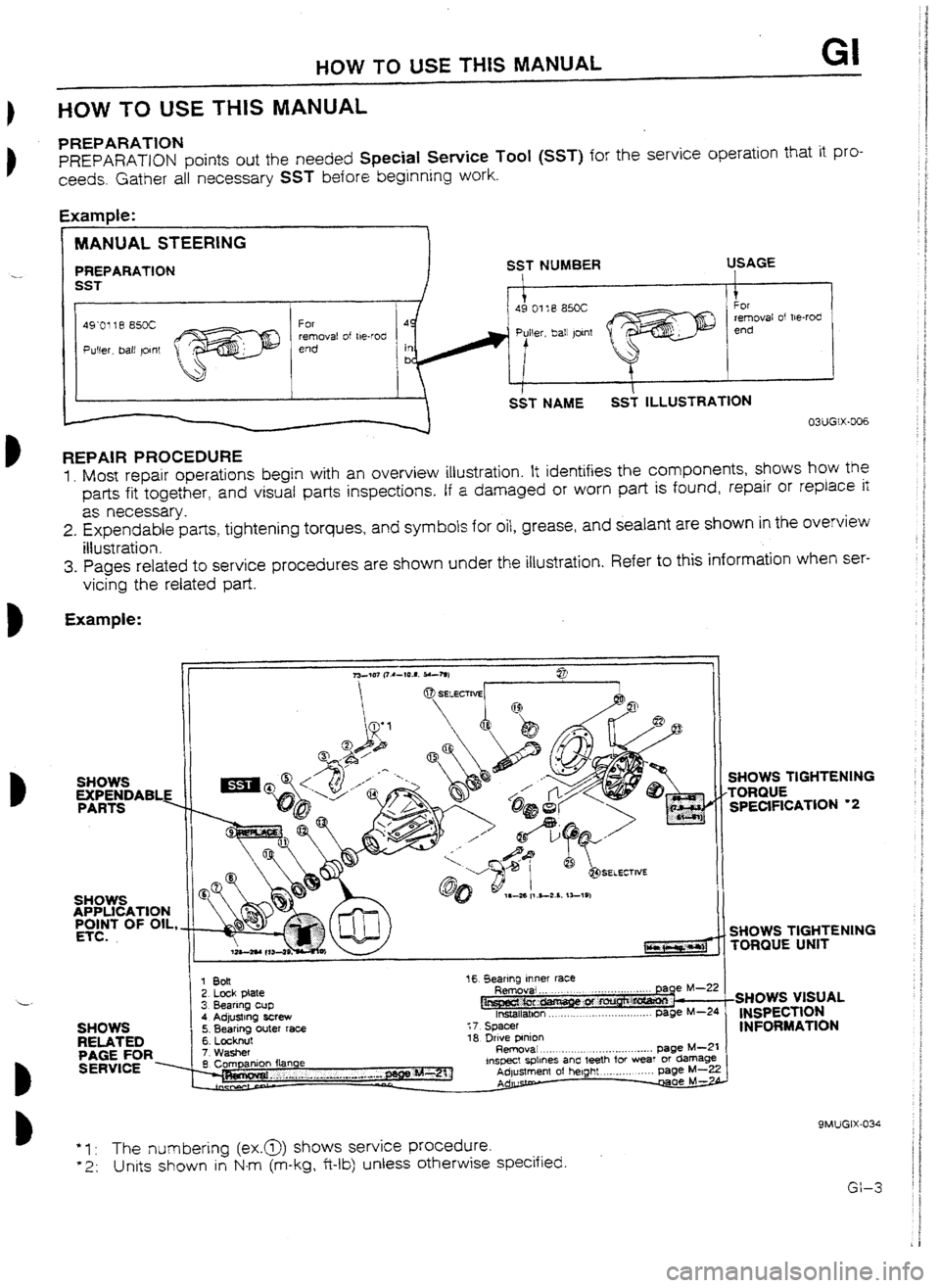
HOW TO USE TtiIS MANUAL GI
HOW TO USE THIS MANUAL
PREPARATION
PREPARATON points out the needed SpeciaI Service Tool (SST) for the service operation that it pro-
ceeds. Gather all necessary SST before beginning work.
Example:
MANUAL STEERING
PREPARATION
remova! of W-rod
REPAIR PROCEDURE I.
Most repair operations begin with an overview illustration. It identifies the components, shows how the
parts fit together, and visual parts inspections. If a
damaged or worn part is found, repair or replace it
as necessary.
2. Expendable parts, tightening torques, and symbols for oil, grease, and sealant are shown in the overview
iItustration.
3. Pages related to service procedures are shown under the illustration. Refer to this information when ser-
vicing the related part.
Example: --__ __-
EXPENDABLE iI
-
SHOWS TlGHTENlNG
TORQUE UNIT
-
SHOWS Zh REiAT&
PAGE FOR 1 8oit
16 Bearing lnne
2. Lock plate Removal . .
,.
3. Bearrng cup
I!.~ f%
fnstallatbon ._ . . . ._. . . . . .
I
A Adirtstma drew - _ ‘.v,--..s ----. 5. Bearing outer race :7 Spacer
G I h-tnllt 1R hriu* mninn
I V. LVYR*IY. .” I.~.1 7Washer Rerr&l'~ .._. . . . . ..__ . . . . . . . ..__......... page M---21
- -0mpanlon f&we inspect spllnes and teeth for wear or damage Adlustment of heloht ._._..... . . . . . DaPe k&Z?
I
r..r...~r.--~.~r....e.-..c~~...~.,~.-*
Q SERVICE x
9MUGlx-034 ‘I : The numbering (ex.@))
shows service procedure. ‘2: Units shown
in N-m (m-kg, Wb) unless otherwise specified.
Page 7 of 677
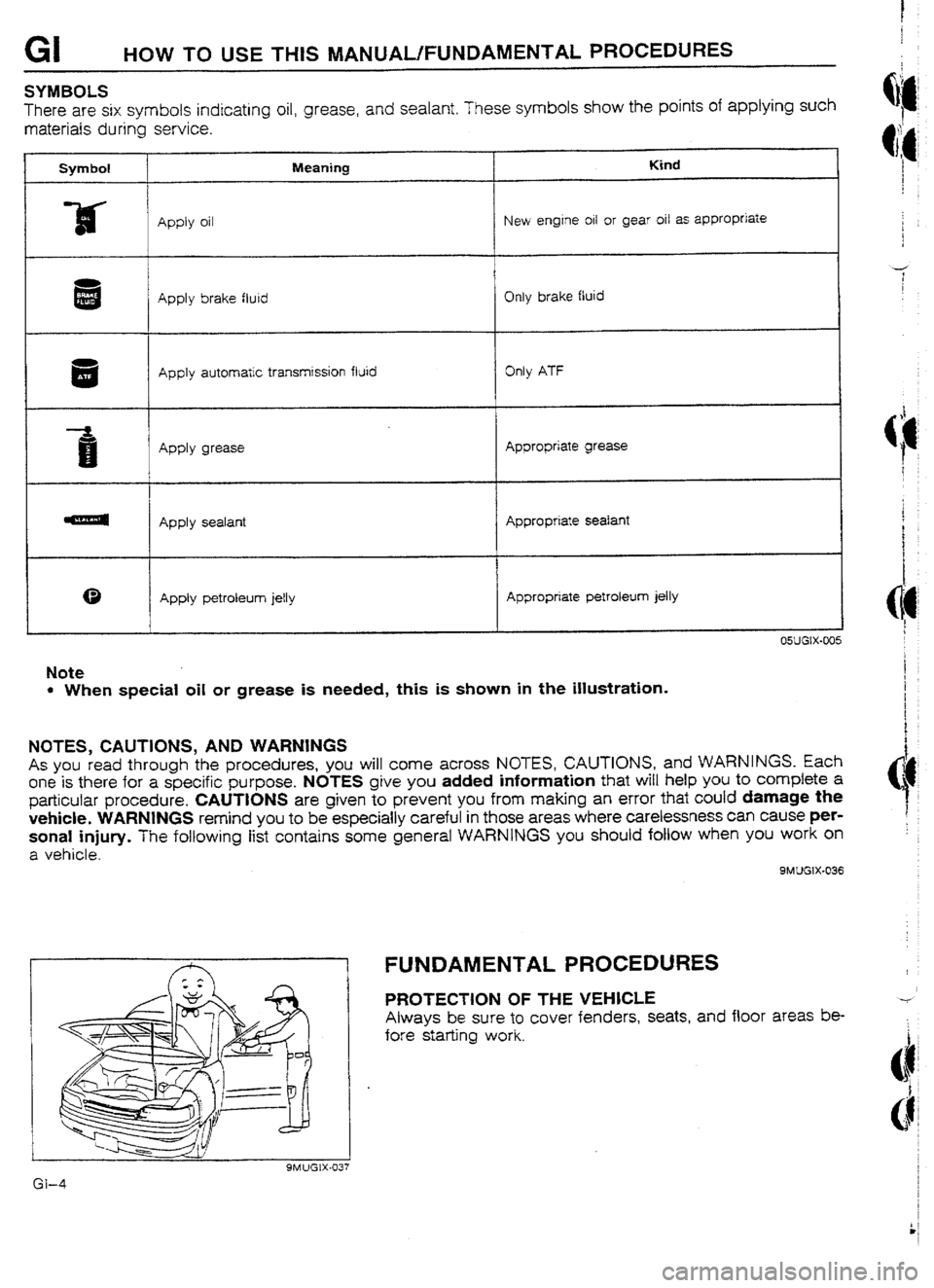
GI HOW TO USE -MS lVlANUAL/FUNDAMENTAL PROCEDURES
SYMBOLS
There are six symbols indicating oil, grease, and sealant.
These symbols show the points of applying such
materials during service.
Symbol
It Meaning Kind
I
Apply oil New engine
oil or gear oil as appropriate
Apply brake fluid Only brake fluid
Apply automatic
transmission fluid
Apply grease Only ATF
Appropriate grease
Appty sealant Appropriate sealant
m
0 Apply petroleum jelty Appropriate petroleum jelly
Note
l When special oil or grease is needed, this is shown in the illustration.
NOTES, CAUTIONS, AND WARNINGS
As you read through the procedures, you will come across NOTES, CAUTIONS, and WARNINGS. Each
one is there for a specific purpose. NOTES give you added information that will help you to complete a
particular procedure. CAUTlUNS are given to prevent you from making an error that could damage the
vehicle. WARNINGS remind you to be especially careful in those areas where carelessness can cause per-
sona! injury. The foliowing list contains some general WARNINGS you should follow when you work on
a vehicle.
9MUGlX-036
FUNDAMENTAL PROCEDURES
PROTECTON OF THE VEHICLE
Always be sure to cover fenders, seats, and floor areas be-
fore starting work.
Page 13 of 677
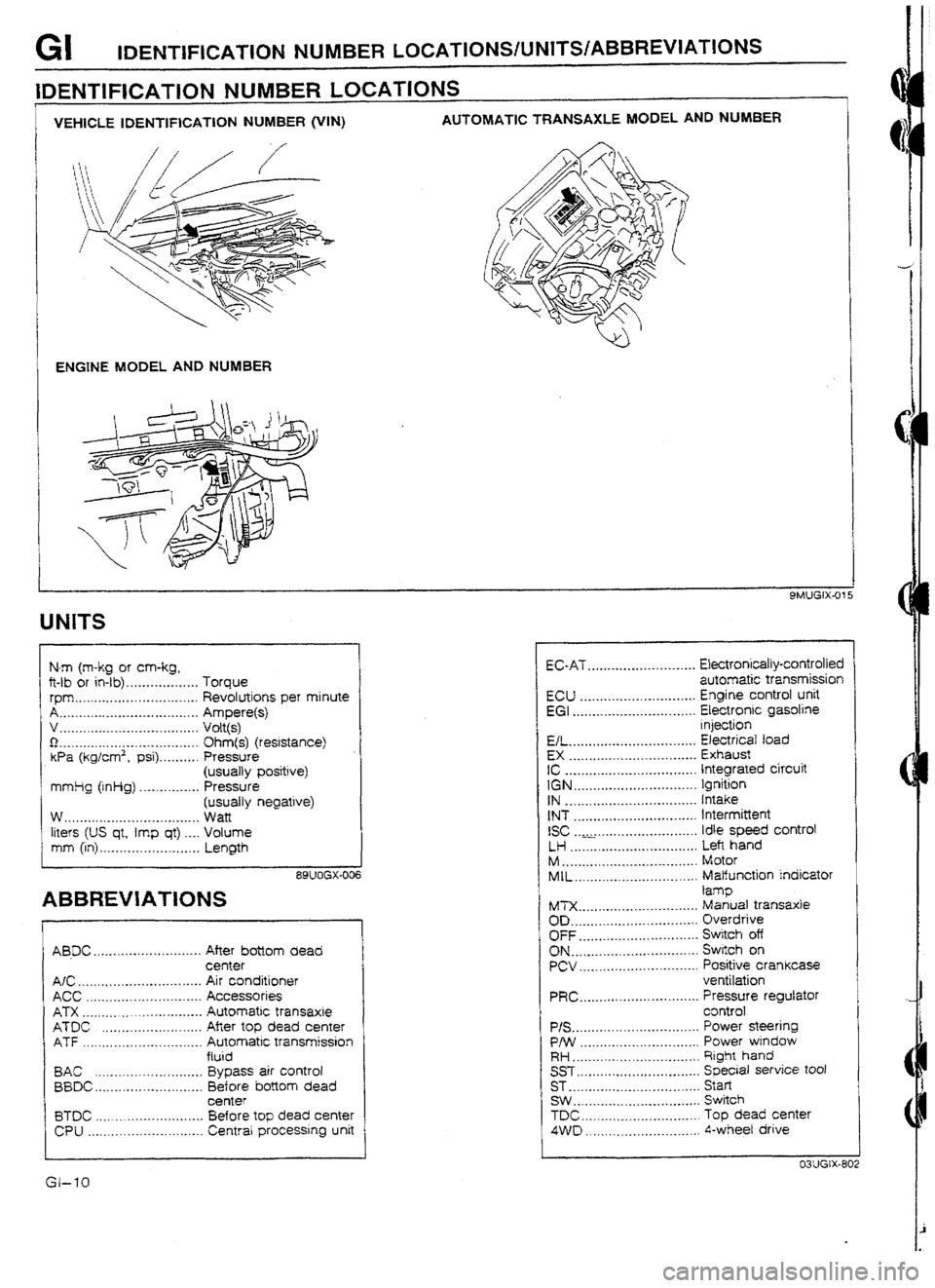
GI IDENTIFICATION NUMBER LOCATIONSIUNITSIABBREVlATlONS
IDENTIFICATCON NUMBER LOCATIONS
I
VEHKZLE IDENTIFICATION NUMBER @‘IN) AUTOMATIC TRANSAXLE MODEL AND NUM8ER
ENGINE MODEL AND NUMBER
UNlTS
N-m (m-kg or cm-kg,
ft-lb or in-lb) . . . . . .._.......... Torque
rpm ._._..._.. . . . . . . .._.._.._. . .._. Revolutions per minute
A . . .._._._...__.._.._.._. .__...._. . . Ampere(s)
v .._.... .* .*... ..__.._...*. ..*. .*. ,. Volt(s)
0 I.._._............**..-.-*..-....... Ohm(s) (resistance)
Wa (kg/cm2, psi) . . . . . . . . . . Pressure
(usually positive)
mmlig (inHg) . . . . . . .._.._... Pressure
(usually negative)
w . . . ..*.....e*.-..-..-.....*.e..... Watt
liters (US qt, imp qt) .._. Volume
mm (in) ,_._.._._..._.,_. .~. . ..__ Length
89UOGX-006
ABBREVIATIONS
AB.DC ........................... After bottom dead
center
A/C _ .............................. Air conditioner
ACC ............................. Accessories
ATX ............................. Automatic transaxte
ATDC ......................... Afier top dead center
ATF .............................. Automatic transmission
ftuid
BAC ........................... Bypass air control
BBDC.. ......................... Before bottom dead
center
BTDC ........................... Before top dead center
CPU ............................. Central processing unit t EC-AT ........................... Ekctronically-controlled
automatic transmission
ECU ............................. Engine control unit
EGI ............................... Electronic gasotine
injection
EL ................................ Electricaf toad
EX ................................ Exhaust
IC ................................. Integrated circuit
IGN ............................... Ignition
IN ................................. Intake
tNT ............................... Intermittent
ISC ............................. Idle speed control
LH ................................ Left hand
M .................................. Motor
MIL ............................... Malfunction indicator
lamp
tb4TX. ............................. Manual transaxle
OD. ............................... Overdrive
OFF .............................. Switch off
ON ................................ Switch on PCV .............................. Positive crankcase
ventilation
PRC.. ............................ Pressure regulator
control
P/S ................................ Power steering
P/W .............................. Power wtndow
RH.. .............................. Right hand
SST ............................... Special service tool
ST .................................
Start
SW . . .............................. Switch
TDC. ............................. Top dead center
4VVD ............................. 4-wheel drive
Page 15 of 677
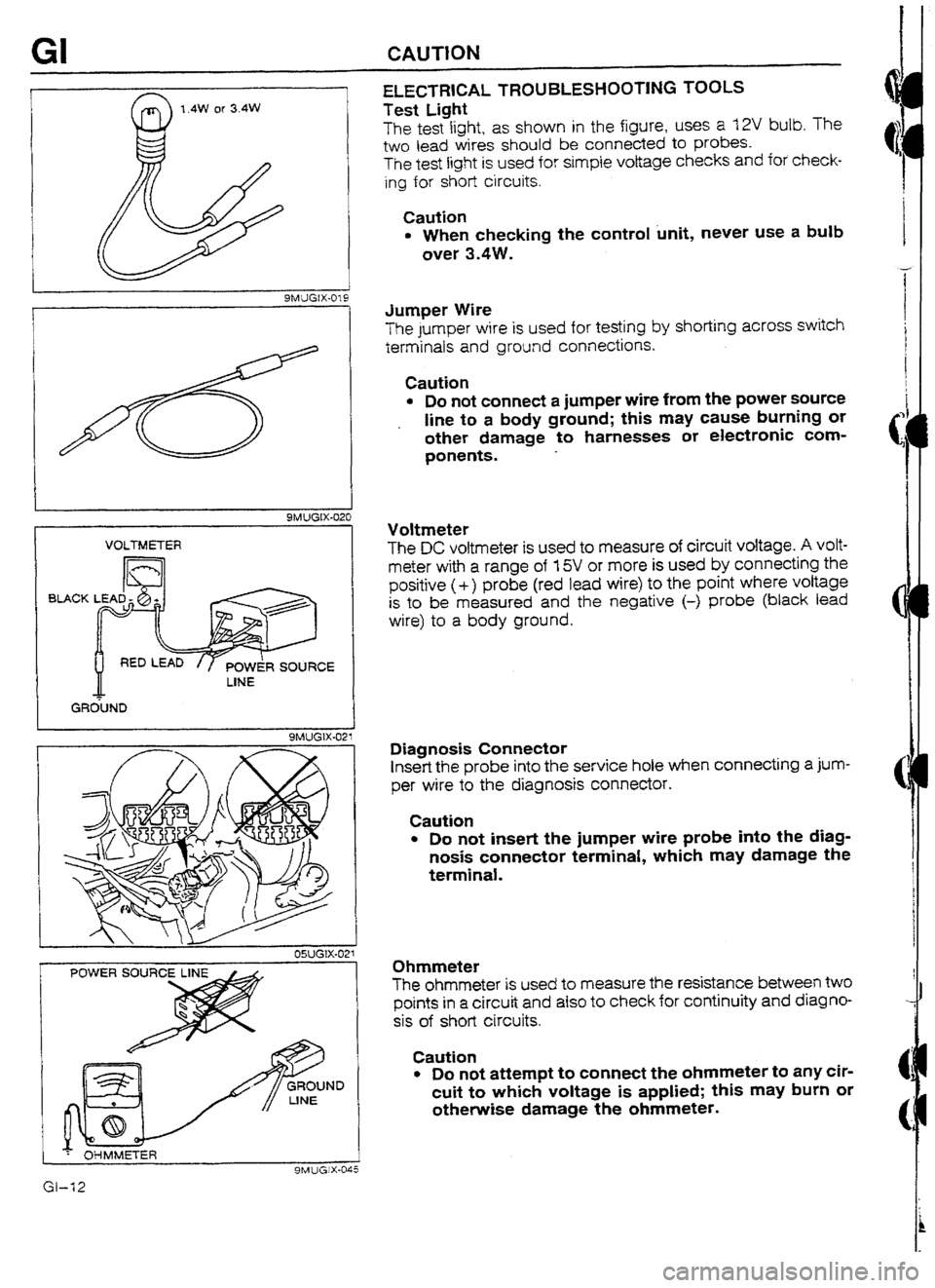
GI CAUTKN
SMUGIX-a21
I VOLTMETER
1 9MUGlX-021
POWER SOURC
ELECTRICAL TROUBLESHOOTING TOOLS
Test Light
The test light, as shown in the figure, uses a f2V bulb. The
two lead wires should be connected to
probes.
The test light is used for simple voltage checks and for check-
ing for short circuits.
Caution
l When checking the control unit, never use a butt,
over 3.4w.
Jumper Wire
The jumper wire is used for testing by shorting across switch
terminals and ground connections.
Caution
l Do not connect a jumper wire from the power source
, line to a body ground; this may cause burning or
other damage to harnesses or electronic com-
ponents. -
Voltmeter
The DC voltmeter is used to measure of circuit
voltage. A volt-
meter with a range of 15V or more is used by connecting the
positive ( + ) probe (red lead wire) to the point where voltage
is to be measured and the negative (-1 probe (black lead
wire) to a body ground.
Diagnosis Connector
Insert the probe into the service hole when connecting a jum-
per wire to the diagnosis connector.
Caution
l Do not insert the jumper wire probe into the diag-
nosis connector terminal, which may damage the
terminal.
Ohmmeter
The ohmmeter is used to measure the resistance between two
points in a circuit and atso to check for continuity and diagno-
sis of short circuits.
Caution
l Do not attempt to connect the ohmmeter to any cir-
cuit to which voltage is applied; this may burn or
otherwise damage the ohmmeter.
Page 20 of 677
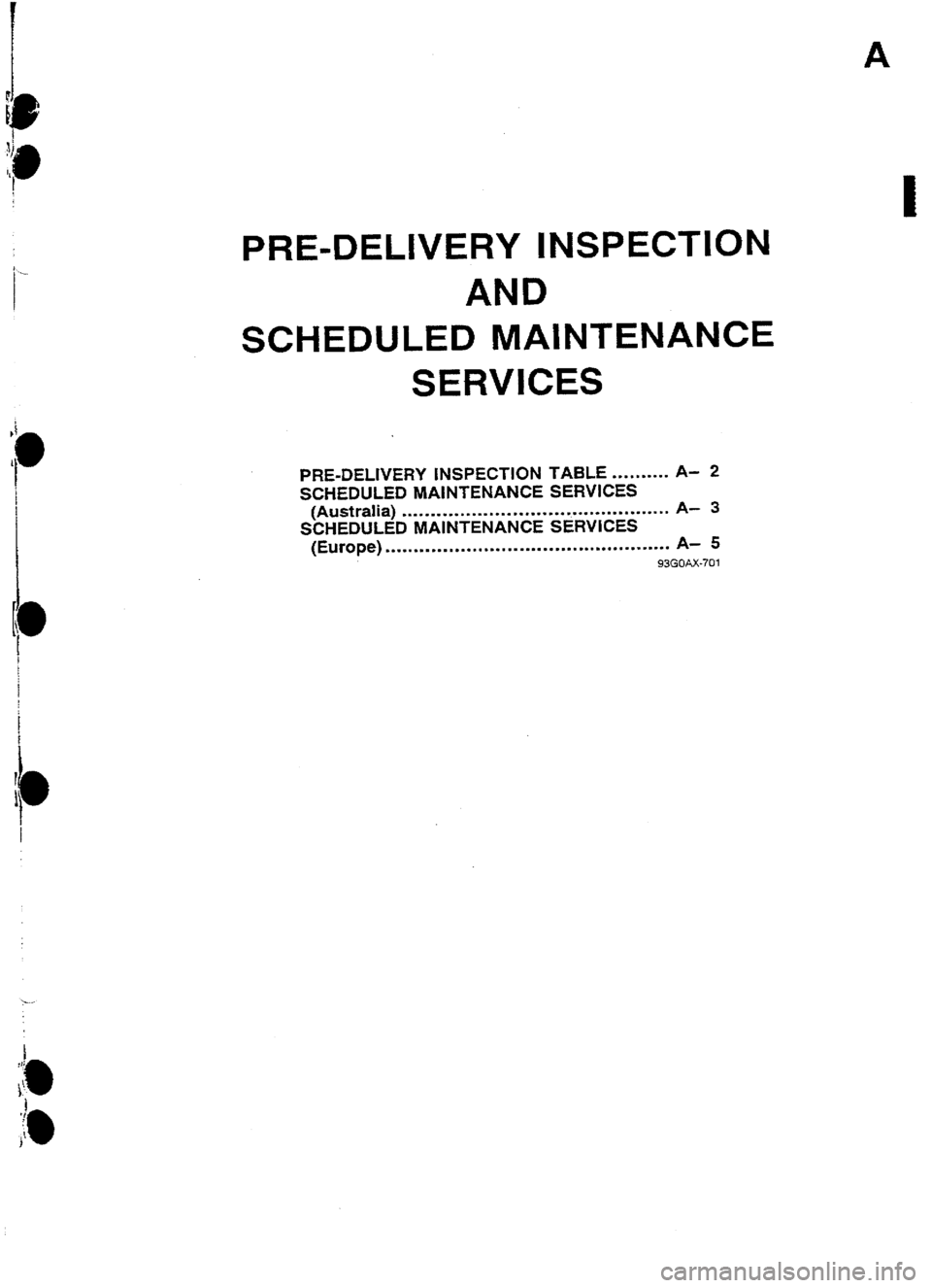
1
I PRE-DELIVERY INSPECTION
AND
SCHEDULED MAINTENANCE
SERVICES
PRE-DELIVERY INSPECTION TA8LE ..-*...a.. A- 2
SCflEDULED MAiNTENANCE SERVICES
(Australia)
. ..* . . . . . . . l . . . . . . . . . . . . . . . . l .*..* . . . . l . . . . . . . A- 3
SCHEDULED MAINTENANCE SERVICES
(Europe)
. . . . . . . . . . . . . . . . . l . . . . . . . . . . . . . . . . . . .*..* . . . . . . . . A- 5
93GOAX-701
Page 22 of 677
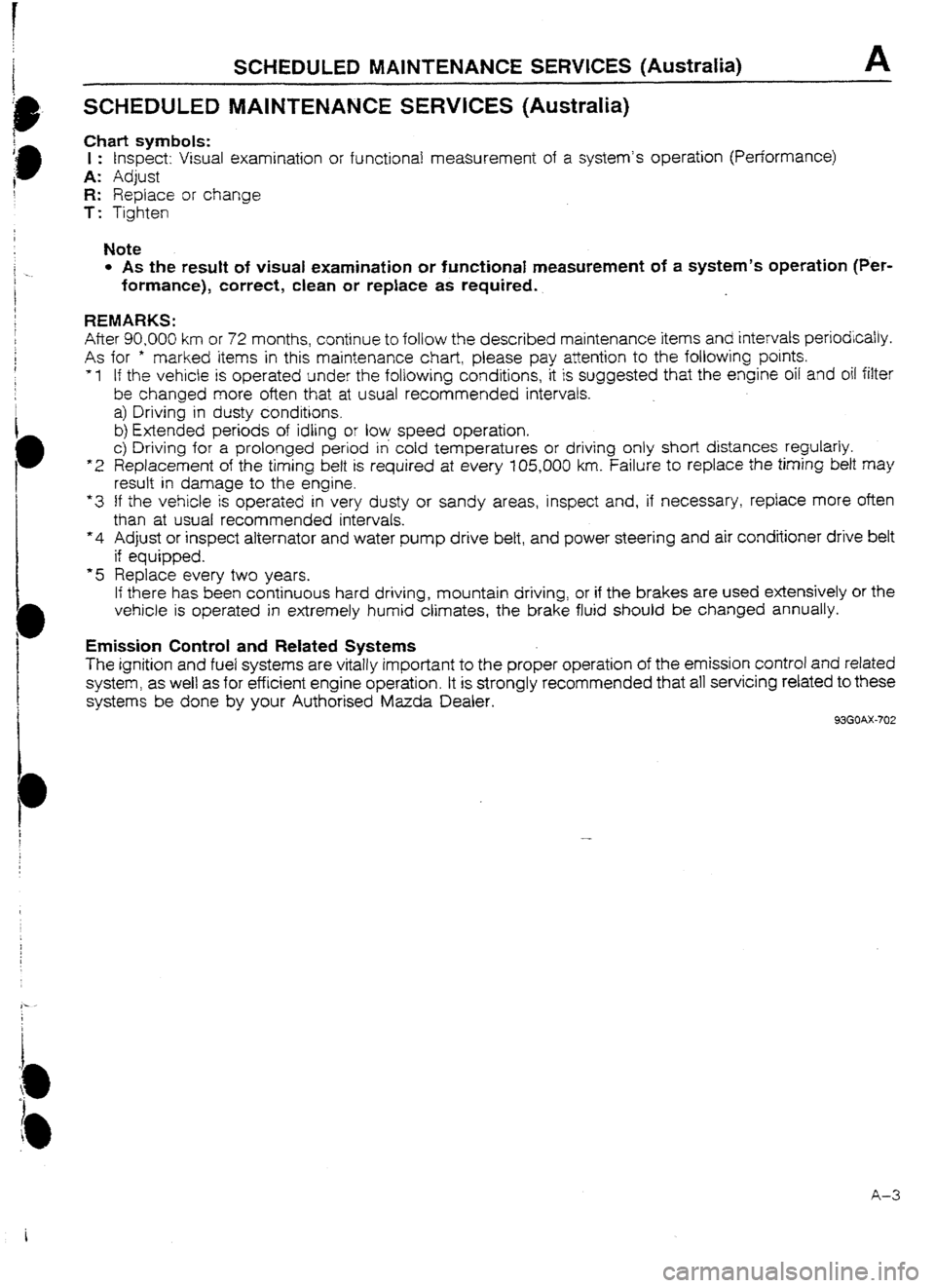
SCHEDULED MAINTENANCE SERVICES (Australia) A
SCHEDULED MAINTENANCE SERVICES (Australia)
Chart symbols:
I : Inspect: Visual examination or functiona! measurement of a system’s operation (Performance)
A: Adjust
R: Replace or change
T : Tighten
Note
l As the result of visual examination or functional measurement of a system’s operation (Per-
formance), correct, clean or replace as required.
REMARKS:
After 90,000 km or 72 months, continue to follow
the described maintenance items and intervals periodically.
As
“I
*2
*3
“4
l 5 for *
marked items in this maintenance chart please pay attention to the following points.
If the vehicfe is operated under the foltowing conditions, it is suggested that
the engine oil and oil f&r
be changed more often that at usual recommended intervals.
a> Driving in dusty condrt,ons.
b) Extended periods of idling
or low speed operation.
c) Driving for a prolonged period iti coid temperatures or driving only short distances regularly.
Replacement of the timing belt is required at every 105,000 km. failure to replace the timing belt may
result in damage to the engine.
If the vehicle is operated in very dusty or sandy areas, inspect and, if necessary, repface more often
than at usual recommended intervals.
Adjust or inspect alternator and water pump drive belt, and power steering and air conditioner drive belt
if equipped.
Replace every two years.
If there has been continuous hard driving, mountain driving, or if the brakes are used extensively or the
vehicle is operated in extremely humid climates, the brake fluid shotlid be changed annually.
Emission Control and Related Systems
The ignition and fuel systems are vitally important to the proper operation of the emission control and related
system, as well as for efficient engine operation. It is strongly recommended that all servicing related to these
systems be done by your Authorised Mazda Dealer.
93GOAX-702
-
A-3 i
Page 23 of 677
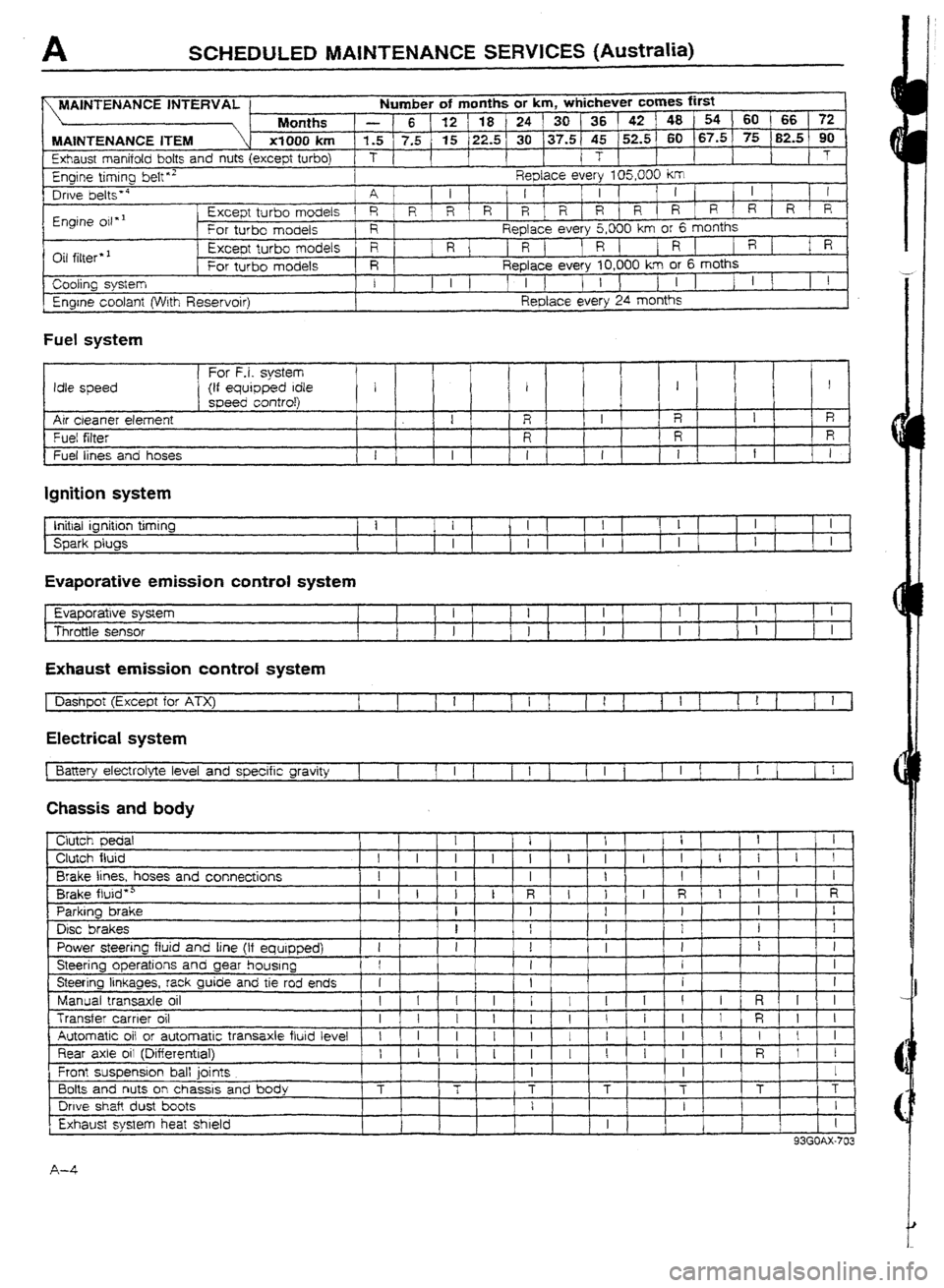
A SCHEDULED MAINTENANCE SERVICES (Australia)
lumber of months or km, whichever cumes first
P
_ 48 54 60 1 66 72
5
60 67.5 75 90 .--- .-- -
.-m-w --v-w _ _ -_-- - - _ _ - -
_ -- - - --- __-
_-
-- -- (82.5
Exhaust manifold bolts and nuts (except turbo) T 1
I i T 1
1 T
Engine timlrtg belt”’ Replace every 105,000 km
Drwe belts * a
A I 1 I 1 1 I 1
! ’ I I 1 1
Engine oil * ’ Except turbo models 1 RIR\R/RIRIRIR R R,R R R/R
For turbo models R
Replace every 5,000 km or 6 months
r-k:1 c:t+*-* 1 Except turbo models
R 1 R 1 1 R ( ) R ( 1 R ( 1
R 1 f R
-
1 VII IIIIc;I 1 For turbo models I R 1 ReDlace everv IO.000 km or E
Engine coolant (Wrth Reservoir)
Fuel
system
Replace e&y 24 months
For F-i. system
Idle speed (if equipped Idle 1 1 1 I
I speed controf)
Air cleaner element 1
R , I R I R
Fuet filter
I I? R R
~ Fuel lines and hoses
1 I 1 I I 1 I I 1 1
Ignition system
t Initial ignition timing
Spark plugs i I I I -1 I I
I I I I I
f
Evaporative emission control system
Evaporative system
Throttle sensor
Exhaust emission contra! system
[ Dashpot
(Except for ATX) I 1 I
1 1 I 1 1 t 1 1 1 1 1 ! 1 1 I 1
Electrical system
Battery electrolyte level and specific gravity ]
I 1 1 I 1 t I ’ 1 1 I 1 f I ( 1
I 1
Chassis and body
Brake lines, hoses and connections
Brake fluid * a
Parking brake
Disc brakes
1 Power steering fluid and line Ilf &uiDDedl
I 1 1 I I I
I 1 1 III II
I ’
I I
Steering operations and gear housing
I
1 1 I --r--j- 1 I
I
Steerino linkanes. rack auide and tie rod pnds .-- --
----.“.a ..‘-~--, J- -.-- _.- .-- -..-- I I I t I 1 1 I I I I I I I 1
Manual transaxle oil I \\!‘I rl\jl I 1 I R III
1 Transfer Automatic carrier oil or 09 automatic transaxle fluid level
1 1 I 1 111 I 1 I l 1 I 1 I 1[11i t I 1 I 1 I I 1 I
R 1 Iii 1 I
1 Rear axle oil (Differential) 1 t I I I I I I I I
t ’ I r . ’ 1 . I I I I I R I 1
I
I I
i T
1 T T T 1 T [ T I 1 T
Front suspension ball joints
Bolts and nuts on chassis and body
I I I . I ! ,
I 1 I . I 1 ’ I I ’
Drive shaft dust boots
I
I 1 I 1
I 1 1 I
~~
- - ’ C1utcl-1 pedat
Clutch fluid
1
A-4
Page 24 of 677
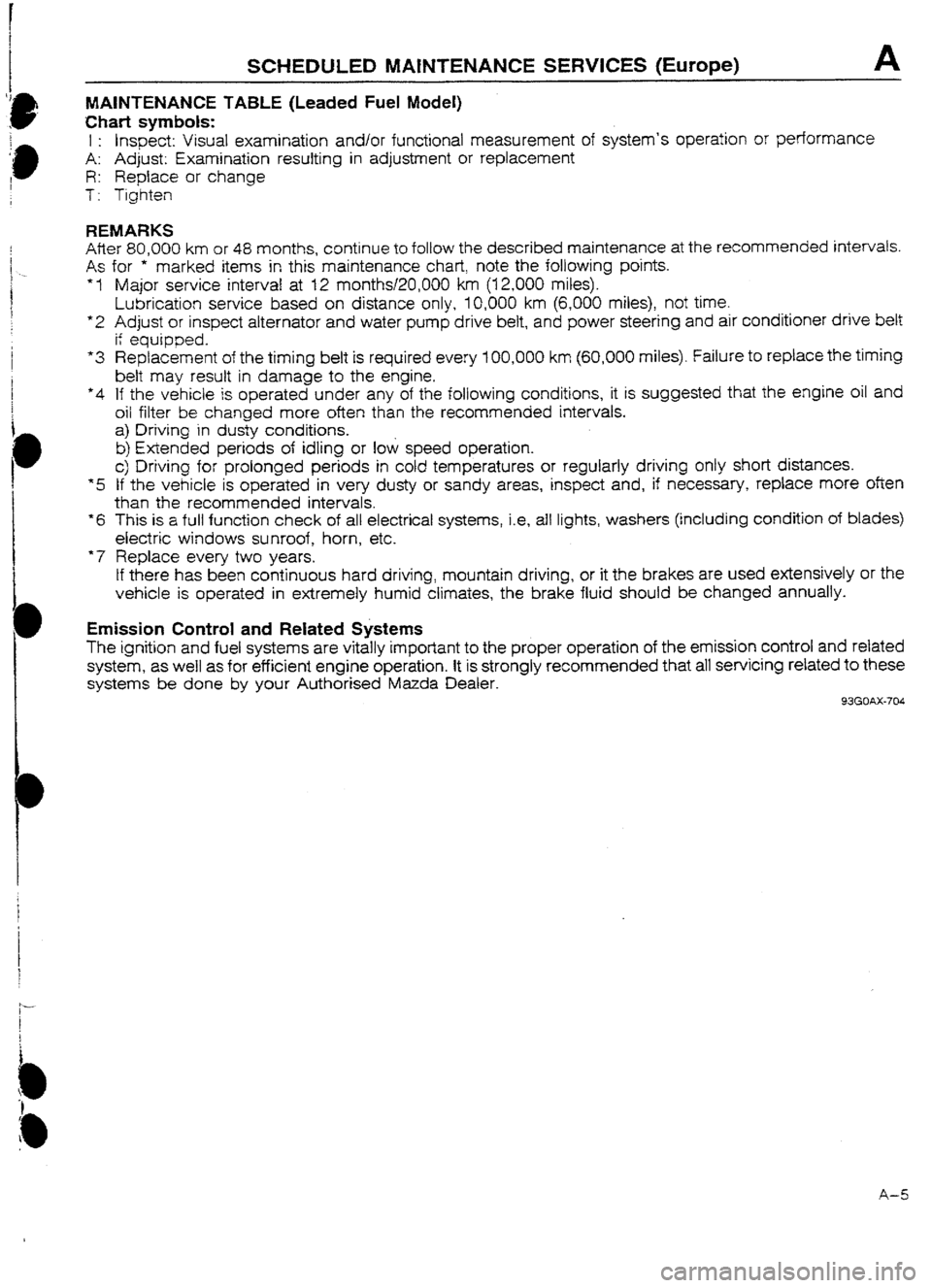
!
i
i
I
i
t-
I
i
i
e
-1
SCHEDULED MAfNTENANCE SERVICES (Europe) A
MAINTENANCE TABLE (Leaded Fuel Model)
Chart symbols:
1 : Inspect: Visual examination and/or functional measurement of system’s operation or performance
A: Adjust: Examination resulting in adjustment or replacement
R: Replace or change
T: Tighten
REMARKS
After 80.000 km or 48 months, continue to foltow the described maintenance at the recommended intervals.
As
*I
*2
“3
*4
*5
*6
*7 for *’
marked items in this’ maintenance chart, note the following points.
Major service interval at 12 months!ZO,OOO km (I 2,000 miles).
Lubrication service based on distance only, 10,000 km (6,000 miles), not time.
Adjust or inspect alternator and water pump drive belt, and power steering and air conditioner drive belt
ii equipped.
Replacement of the timing belt is required every ICQOUO km (60,000 miles). Failure to replace the timing
belt may result in damage to the engine.
If the vehicle is operated under any of the following conditions, it is suggested that the engine
oil and
oil filter be changed more often than the recommended intervals.
a) Driving in dusty conditions.
b) Extended periods of idling or low speed operation.
c) Driving for prolonged periods in cold temperatures or regularly driving only short distances.
If the vehicle is operated in very dusty or sandy areas, inspect and, if necessary, replace more often
than the recommended intervals.
This is a full function check of all electrical systems, i.e, afl lights, washers (inctuding condition of blades)
electric windows sunroof, horn, etc.
Replace every two years.
tf there has been continuous hard driving, mountain driving, or it the brakes are used extensively or the
vehicle is operated in extremely humid climates, the brake fluid should be changed annually.
Emission Control and Related Systems
The ignition and fuel systems are vitally important to the proper operation of the emission control and related
system, as well as for efficient engine operation. It is strongly recommended that all servicing related to these
systems be done by your Authorised Mazda Dealer.
93GOAX-704
A-5